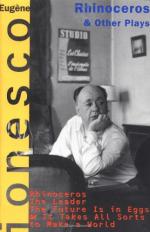|
This section contains 485 words (approx. 2 pages at 300 words per page) |

|
In the play Rhinocéros (1959) Eugène Ionesco creates a dynamic pattern by juxtaposing the archetypal motif with its infernal inversion. The audience, while watching society's spiritual decline and hopeless loss of identity, witnesses the rebirth of a slovenly drunk, unable to cope with life, who becomes a staunch, defiant defender of humanity. The first act opens with a picture of society in which everyone follows his narrow interests. And though people (an alcoholic, a grocer, a café owner, a logician, a housewife) live side by side, they fail to establish a truly human relationship—in the sense of Schiller, Buber, Camus, or Heidegger—because they lack the courage for existential encounter with each other. When their mode of life is threatened by the sudden appearance of a rhinoceros they are momentarily united by a common feeling of loathing and terror.
But as soon as they relate the...
|
This section contains 485 words (approx. 2 pages at 300 words per page) |

|


